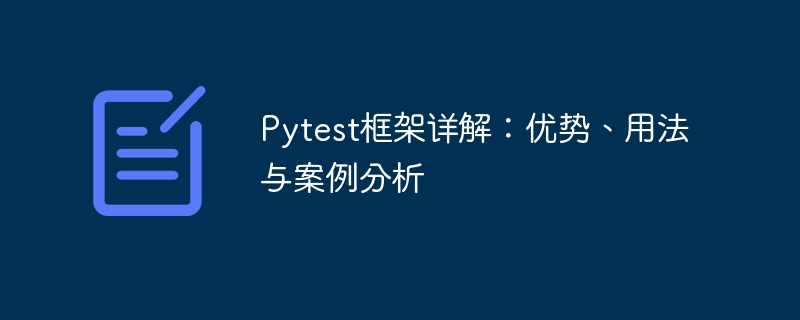

Detailed explanation of Pytest framework: advantages, usage and case analysis
Introduction:
In the software development process, unit testing is a very important link, it can Help us find problems in the code and ensure the quality of the code. For the Python language, the Pytest framework is a very powerful tool that can simplify the writing and execution of unit tests. This article will introduce the advantages and usage of the Pytest framework in detail, and use case analysis to help readers better understand and apply the framework.
1. Advantages of the Pytest framework
2. Usage of Pytest framework
Installing Pytest
Before using Pytest, you need to install the framework. You can use the pip command to install:
pip install pytest
Writing test cases
When writing test cases, we only need to use Python functions to represent a test function and use specific Naming rules to identify test cases. Usually we add the "test" prefix in front of the test case file name or the test case function name. For example, we wrote the following test case file test_calc.py:
def test_add(): assert 1 + 1 == 2 def test_sub(): assert 3 - 1 == 2
Run the test case
After we finish writing the test case, we can use the Pytest framework to run these tests Example. Switch to the directory where the test cases are located on the command line and execute the following command:
pytest
Pytest will automatically discover and execute all test cases, and output the corresponding test results in the console.
3. Case analysis of Pytest framework
In order to better understand and apply the Pytest framework, we will analyze it with a simple example. Suppose we need to test a simple calculator program.
Writing test cases
We first write a test case file calc_test.py to test addition and subtraction in the calculator program:
def test_add(): assert add(1, 1) == 2 def test_sub(): assert sub(3, 1) == 2
Among them, add and sub are the addition and subtraction functions in the calculator program respectively.
Writing a calculator program
Next, we write a simple calculator program calc.py, including add and sub functions:
def add(a, b): return a + b def sub(a, b): return a - b
Run the test case
Switch to the directory where the test case is located on the command line and execute the following command:
pytest
Pytest will automatically discover and execute the test case in calc_test.py and output Corresponding test results.
Summary:
This article provides a detailed introduction to the Pytest framework, including the advantages, usage and case analysis of the framework. As a powerful testing framework, Pytest can help us simplify the writing and execution of unit tests and improve testing efficiency. By mastering the usage of Pytest and applying it to actual projects, we can better conduct software testing and ensure code quality.
The above is the detailed content of In-depth analysis of the Pytest framework: features, applications and case analysis. For more information, please follow other related articles on the PHP Chinese website!